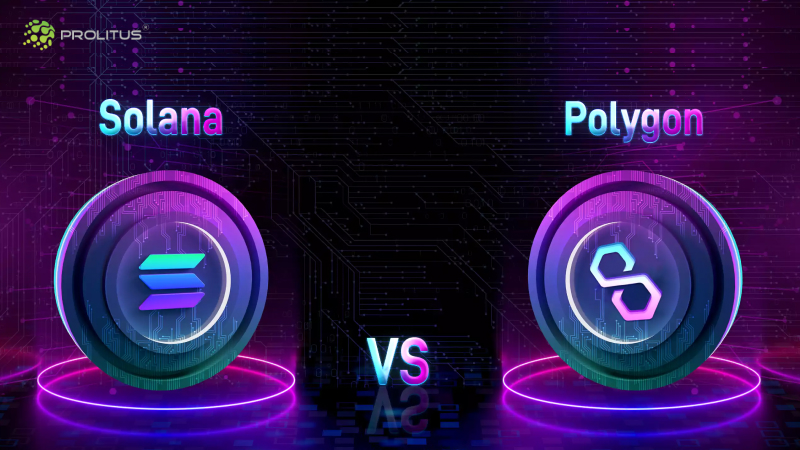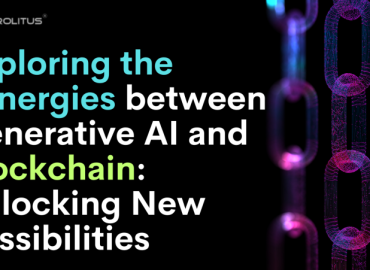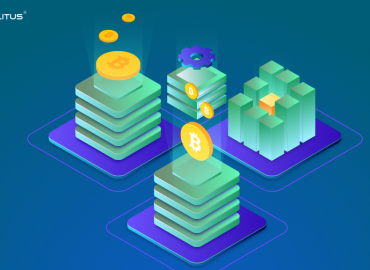Blockchain is one of the most talked about technology in the entire world. A few years back, this might have been seen as unrealistic, that from investors to businesses, all would be just talking about the progress and immense capabilities of blockchain technology. But just like any other technology, blockchain has various issues like lack of scalability, higher gas fees, low transaction speed, etc. However, with new blockchain networks like Polygon and Solana, all these problems are getting addressed.
Thus, this article will discuss both blockchains, i.e., Solana and Polygon. Moreover, we will also compare both of these blockchains so that you can figure out which one to go with per your needs and requirements. So let’s jump right into it, starting with introducing these blockchains.
What is Solana?
Solana is a third-generation blockchain network founded by Anatoly Yakovenko in 2017, primarily to solve the scalability issues of traditional blockchains. It has also got the nickname “Ethereum Killer” due to its capability to overcome the loopholes in the Ethereum blockchain.
Solana focuses explicitly on providing scalability and processing transactions faster; thus, it has become one of the most preferred blockchains for developing Dapps. Moreover, Solana has one of the largest ecosystems running under its roof, which covers over 400 NFTs, DeFi, and Web3 projects. However, in recent times, Solana has faced frequent downtime and hacks, which has raised questions about the future of Solana.
Features of Solana Blockchain
Various features power Solana, but in this section, we will cover a few of the unique features of the Solana blockchain. So let’s have a quick look over them:
- Solana uses the Byzantine Fault Tolerance (BFT) algorithm, which ensures that the failure of a particular node doesn’t impact the entire working of the network.
- It uses the Proof-of-History (PoH) consensus mechanism so that every node can take its own decisions rather than depending on other nodes.
- It divides various blockchain nodes into smaller packets and process data across multiple hardware to optimize the transaction speed.
- It uses multiple smart contracts simultaneously, reducing the transaction cost and increasing the speed.
What is Polygon?
Polygon (formerly known as Matic) was started in 2017 by Jaynti Kanani, Sandeep Nailwal, and Anurag Arjun and has emerged as one of the most lucrative blockchain networks for developers and investors. It is a Layer 2 scaling solution that aims to help Ethereum overcome issues like higher gas fees, low transaction speed, lack of scalability, etc.
Thus, Polygon helps developers to build Daaps on its platform, which isn’t just scalable. But they also come with various advantages from Ethereum, like a vibrant ecosystem, high-end security, and openness. Moreover, Polygon also helps Ethereum transform into an “Internet of blockchains’, ‘which is also known as a multi-chain system. However, it should be noted that the multi-chain system provided by Polygon is quite similar to that of the Cosmos, Polkadot, and Avalanche blockchain networks.
Features of Polygon Blockchain
Polygon has various unique features, but we will discuss them in the next section, where we will compare Polygon with Solana. So in this section, let’s have a broader look over some of the unique features of Polygon:
- Polygon is a Layer 2 scaling solution; thus, it sits on top of Ethereum and enjoys the benefits of both blockchains.
- It is the only scaling solution that extends the support to Ethereum Virtual Machine (EVM).
- It supports two types of chains (multi-chain), i.e., secure and standalone.
Solana vs. Polygon: Similarities and differences
In the below table, we have covered a broader overview of the similarities and differences between Solana and Polygon.
Criteria
Polygon
Solana
Year of Launch
2017
2017
Consensus Mechanism
PoS Plasma State Sidechain
PoS and PoH
Native Token
MATIC
SOL
Token Type
ERC-20
Altcoin
No. of Transactions
Up to 72,000 TPS
Up to 65,000 TPS
Transaction Fees
$0.018
$0.00025
Architecture
Multichain
Stateless
Programming Language
Golang, Solidity, Vyper
Rust, C, C++
Scalability
Multi-chain solutions offer high-end scalability
High-performance protocols ensure scalability
Decentralized
Highly decentralized
Decentralization is less compared to Polygon
Security
Highly secure
Security is less compared to Polygon
Now it’s time to have a deeper understanding and compare Solana and Polygon based on some prominent factors used to evaluate blockchain networks.
1. Transaction Speed
The transaction speed of a particular blockchain is a crucial factor to be checked while comparing the blockchain platforms, as the faster the blockchain, the more transactions it can handle. For example, Solana uses Tower Byzantine Fault Tolerance (tBFT), which eliminates the need for real-time communication between the nodes.
Along with that, Solana also uses Gulfstream, which helps push the transactions toward the edge. This further helps network validators to process transactions at a much faster pace. So, with this in place, Solana can handle 65,000 Transactions Per Second (TPS).
On the other hand, Polygon is still ahead of Solana as it can support around 72,000 Transactions Per Second (TPS). This makes Polygon unbeatable in terms of speed.
2. Scalability
Scalability is one of the biggest issues hindering the growth of some top blockchain networks like Bitcoin and Ethereum. So it’s a great parameter to check on.
The best part here is that Solana and Polygon are free from scalability issues, as they can handle large volumes of transactions. Specifically, Solana uses high transaction speed, an efficient consensus model, and improved architecture to overcome the problem of scalability. However, Polygon still beats Solana as it supports lightning-speed transactions, making it highly fast, efficient, and scalable. Thus, developers are giving higher preference to Polygon compared to Solana for developing Dapps.
3. Tokenomics
Solana and Polygon have quite similar tokenomics, as they incentivize the stakers with rewards to secure the network. So if we talk about the average staking rewards, then here also, both Solana and Polygon offer almost the same 8% return.
However, the inflation rate of Solana is 8%, which is less than Polygon’s 10% inflation rate. This means that every year, Solana mints fewer tokens than Polygon. Thus, Solana has better tokenomics than Polygon, as Solana’s rewards and inflation rate are both even.
4. User Experience
User experience is vital as it highlights which blockchain network serves its users more satisfactorily. Unfortunately, Solana has a comparatively lousy user experience as it isn’t an EVM-compatible network. Thus it becomes hard for users to move the funds to and fro from the Solana network to other popular networks like Optimism, Fantom, Avalanche, etc.
On the other hand, as Polygon is EVM compatible, users don’t face any issues, and transactions can be carried out efficiently without paying high transaction fees. So Polygon leads in the user experience.
5. Architecture
Another critical comparison is the blockchain’s underlying architecture. There are mainly two types of architecture, i.e., stateless and stateful. The architecture is considered stateless if the blockchain’s state and storage variable values can’t be modified.
Solana works on a stateless architecture, which means that the state of the entire blockchain doesn’t need to be updated with every transaction. On the other hand, the concept behind Polygon architecture is a borderless community where exchanges exist in the form of clusters, and the system functions like a POS blockchain. Here, both architectures have advantages and disadvantages, making it hard to decide the best one.
6. Emerging market dominance
There are various emerging markets in the crypto space, like DeFi, NFTs, GameFi, etc., so let’s look at who rules these lucrative markets.
-
DeFi
Decentralized finance (DeFi) applications are getting much attention in crypto. Currently, Solana is dominating here with a $5.5 billion Total Value Locked (TVL) compared to Polygon’s $3.8 billion Total Value Locked on the DeFi applications.
However, Polygon is quickly taking over the market due to the support of various applications like Curve, AAVE, Stargate, and QuickSwap. These DeFi applications give investors easy returns of up to 10% on Stablecoins and a better user experience than Solana.
-
NFTs
The craze around NFTs doesn’t seem to slow and is increasing daily. Solana provides a superior experience compared to Polygon, primarily due to its strong integration with OpenSea, one of the biggest platforms for trading NFTs. Interestingly, Polygon has also integrated with OpenSea to allow users to trade MATIC native NFTs, but they hardly have any volume.
-
GameFi
GameFi has revolutionized the entire gaming industry by providing a way for players to earn money by playing games. Here, both Solana and Polygon seem to have an equal presence. While Solana is home to games like Neopets and Aurory, Polygon has popular games like Crypto Unicorns and Crypto Raiders.
Well known projects
Some well-known projects built on Polygon include:
- JellySwap
- Easy Fi
- Augur
- ZED RUN
- QuickSwap
- Opacity
- SportX
- Mai Finance
- Impermax
- gTrade
- QuickSwap
- IDEX
Now let’s look at some of the most famous projects built on Solana:
- StepN
- Sollamas
- Civic
- NATION
- Star Atlas
- Solsea
- BR1 Metaverse
- Audius
- Hello Moon
- AcademySolPunks
Why should you hire Prolitus?
We at Prolitus are a leading blockchain development company in the crypto space. Our highly skilled team has the relevant experience and expertise required for delivering blockchain development services. Furthermore, our services aren’t just limited to the development part; instead, we provide post-development support so that you can focus on growth areas without worrying about the backend part.
Our prominent blockchain development services include:
- NFT Marketplaces
- Exchange Platform Development
- Smart Contract Development
- dApps Development
- Parachain Development
- Wallet and Node Development
- KYC Blockchain Solutions
So, whatever your requirements and business goals are, our experts are fully equipped to serve and fulfill them in the best possible timeframe.
Final Thoughts
With the rapidly changing crypto space, there is a vast scope for innovation, upgrades, and mass adoption. Especially the emerging markets in the crypto space, like DeFi, GameFi, NFT, Metaverse, Smart Contracts, etc., will scale enormously. Thus, Solana and Polygon have a huge market to capture and establish dominance.
Moreover, commenting on which is the best is currently hard and too early, as both of these blockchains have their own pros and cons. Thus, it greatly depends on your business requirements and goals to choose which one to go with. However, one thing is pretty straightforward: currently, it’s the right time to build and leverage blockchain technology. So get in touch with Prolitus and let our experts handle all your needs and requirements.
Frequently Asked Questions (FAQs)
Q1) What is the difference between Solana and Polygon?
Some of the major differences between Solana and Polygon are: The transaction cost in Solana is less compared to Polygon The transaction speed in Solana is less compared to Polygon The ecosystem of Solana is greater compared to Polygon The community power of Polygon is higher compared to Solana The blockchain network of Polygon is more secure compared to Solana
Q2) Is Polygon faster than Solana?
Yes, Polygon is faster than Solana as Polygon can process 72,000 TPS compared to 65,000 TPS of Solana.
Q3) Which one is better, Solana or Polygon?
It is hard to declare a clear winner between Solana and Polygon because, in a few parameters, Polygon takes the lead, while in a few others, it's Solana leading the path. So if you want to give preference to tokenomics and emerging market dominance, Solana is better than Polygon. However, if your priorities are more scalability, fast transaction speed, and security, then Polygon is better than Solana.





